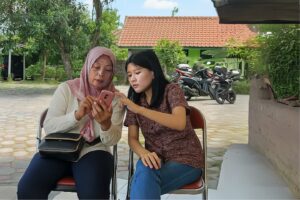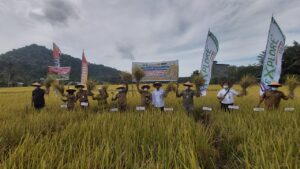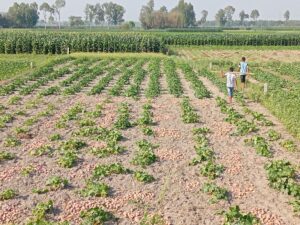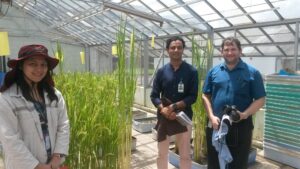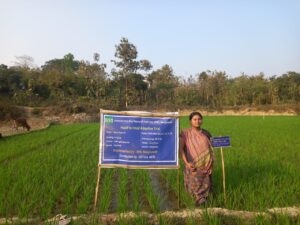
Maize ears from CIMMYT’s collection, showing a wide variety of colors and shapes. CIMMYT’s germplasm bank contains about 28,000 unique samples of cultivated maize and its wild relatives. Photo: Xochiquetzal Fonseca/CIMMYT.
Unlike rice, which traditionally has been a staple food of many Bangladeshis, maize was mostly viewed as a minor crop until government initiatives and favorable market opportunities and conditions created a demand for it.
Before its independence in 1971, Bangladesh rarely cultivated maize, and, about 18 years ago, it did not have an established market. Thus, farmers were not interested in cultivating or in properly integrating maize with other traditional crops such as rice and wheat.
However, in the 1980s, the government began efforts to promote maize to local farmers to boost the country’s food supply. By the 1990s, demonstration plots were set up in farmers’ fields to increase awareness about the crop and expand its cultivation. Progress was slow, however, and, in the early 1990s, only a few farmers had adopted maize.
The lack of an existing market during that time was not the only dilemma. People also were not accustomed to mixing maize flour with wheat to make chapati, a round, flat unleavened bread and common household meal in Bangladesh. But, quite favorably, expansion of the poultry, fisheries, and livestock industries in the country brought with it previously unseen opportunities for maize.

A feed market Initially, the demand for maize as feed was met by imports from Thailand, the United States, and India, among other countries. Soon, poultry farm owners turned to locally produced maize and the country imported only what it needed to fill the gap. As the industries grew, however, so did the demand and market for maize. Maize gradually comes out of rice and wheat’s shadows to offer its own set of benefits to farmers in Bangladesh Because of the growing poultry market, the area planted with maize increased to about 220,000 hectares in 2008 from 179,000 hectares in 2007 and 137,000 hectares in 2006. The country’s poultry industry provides a cheap source of protein and employs about 5 million people. Millions of households rely on this industry for their nutrition and for generating income.
In the last 2 decades, this industry has grown at about 20% per year. It is still expected to grow because, as the population continues to rise, so does its per capita consumption of chicken and eggs. This projected growth seems likely in the future given that the industry also does not seriously suffer from bird-flu outbreaks.
Aside from the poultry industry, the cattle and fish industries also have a demand for maize as feed. And, in some rural and urban areas, maize is mixed with wheat to make chapati. Moreover, maize has an extra value as farmers use its leaves and stems to feed their dairy cattle.
With bright market potential, the area planted with maize increased dramatically in the last few years. But, since these systems grew in significance only during the 2000s, concerns over their sustainability have emerged only recently.
Rice and maize have almost completely opposite requirements in terms of soil environment. Rice requires well-puddled clayey soil with high waterholding capacity. On the other hand, maize needs a loamy soil, which is well aerated and has good tilth. Working on the soil then becomes tricky for farmers who do not want to sacrifice rice but want to try maize so they can have an added market opportunity.
Other problems are the improper or low use of irrigation, imbalanced use of fertilizers, and the need for guided principles or technologies for sustainable management.
Sustainability is key

In 2008, the International Rice Research Institute (IRRI) started collaborating with the International Maize and Wheat Improvement Center (CIMMYT), and International Plant Nutrition Institute, as well as national partners such as the Bangladesh Agricultural Research Institute, Bangladesh Rice Research Institute, Bangladesh Academy of Rural Development, Bangladesh Rural Advancement Committee, and Rangpur- Dinajpur Rural Services on an initiative called the Sustainable Intensification of Rice-Maize Production Systems in Bangladesh.
Supported by the Australian Centre for International Agricultural Research (ACIAR), this 5-year project aims to enhance rice-maize systems in the districts of Comilla, Rajshahi, and Rangpur, where farmers’ yields, in most cases, are low because of factors such as late planting of maize after rice in the rabi season, the use of recycled hybrid maize seeds, soil fertility depletion, excess moisture during germination and seedling establishment of rabi maize, waterlogging and crop damage due to heavy storms during the harvest of kharif-1 maize, water stress due to no or deficit irrigation, the low use of fertilizers other than nitrogen, and high production costs resulting in reduced input use. Hybrid maize is usually a high yielder but these factors result in actual yields that fall behind attainable yields.
Under this project, interventions such as screening and adapting maize varieties that are tolerant of excess moisture, enhancing nutrient management, testing conservation agriculture (CA) practices, and using resource-conserving technologies and then outscaling them to intended stakeholders (farmers, extension workers, and local researchers to name a few) have been started and will continue through the project’s 2-year implementation and completion period.
From the project’s inception in 2008, village farm surveys and group discussions with major stakeholders took place to help researchers gain useful insights into the rice-maize sector and its production systems. Household surveys also accompanied those first data-gathering activities, which would later help monitor and assess the project’s impact.
At all project sites, researchers handle trials on nutrient management while both farmers and researchers jointly manage adaptive trials on CA practices. CA is founded on principles that aim to reduce mechanical soil disturbance as much as possible to maintain soil nutrients, prevent water losses, and avoid erosion. Increasingly, a lot of farmers, not just in Bangladesh but also in other parts of South Asia, have been adopting resource-efficient CA practices instead of their traditional farming ways.
More than just research Though the project initially focused on adaptive research in farmers’ fields, it has now started emphasizing the dissemination of improved CA practices and site-specific nutrient management. Several farmers’ field days and traveling seminars became the avenue for farmers, extension workers, and scientists to interact.
During a series of farmers’ field days, farmers gathered around fields and shared their experiences, as well as discussed the benefits and constraints of farming using CA practices.
“Farmers improve on their practical knowledge of managing their production systems,” said Jagadish Timsina, IRRI senior scientist and project head. “And, through interacting with scientists, farmers become more willing to try new practices as they begin to understand these systems more.
“These activities also provided ways in which project partners and stakeholders could help each other build their capacities further,” Dr. Timsina added.
In another activity, farmers learned about using power tiller-operated seeders (PTOS) with different seed-metering devices and a bed former or planter. PTOS help farmers directly seed rice and maize while a bed former or planter assists farmers in making raised beds and planting crops on those beds.
The use of appropriate and affordable machinery was promoted in the project for farmers to rapidly establish rice, maize, and other crops under different CA-based tillage systems such as zero tillage, reduced and minimum tillage, and raised beds. These machines have also been tested for planting other crops such as mungbean in Rangpur and Rajshahi.
This project has been using and evaluating PTOS and the bed planter at its target sites according to Dr. Timsina. Agricultural engineers of national agricultural research institutions involved in the project have been helping to refine these machines continually so they could be used to maintain the precise depth of sowing as well as the desired plant population in different soils and climates in the country.
Through the project’s capacitybuilding activities, more than 100 extension workers, farmers, and personnel from government and nongovernment organizations, among others, have been trained in operating and maintaining farm machinery such as PTOS and the bed planter. By enhancing the capacity of major stakeholders in the management of rice-maize production systems, it is hoped that, in the not-too-distant future, intensive yet sustainable ricemaize systems will be possible, and will generate more year-round on-farm employment and income for Bangladesh’s rural workforce.
_____________________________________
Ms. Ferrer is a science communication specialist at the International Rice Research Institute.

